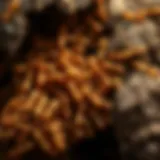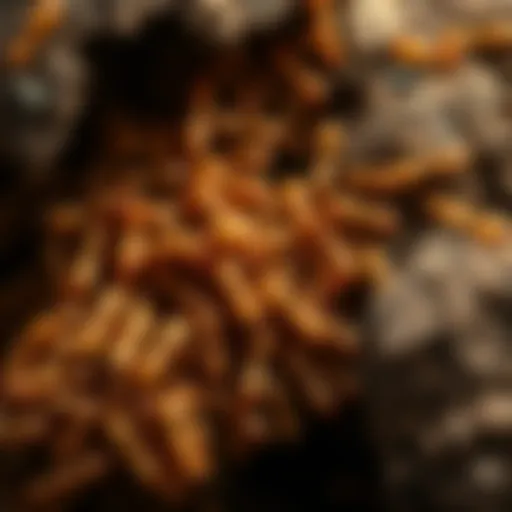Understanding Termite Treatment: Essential Insights for Homeowners
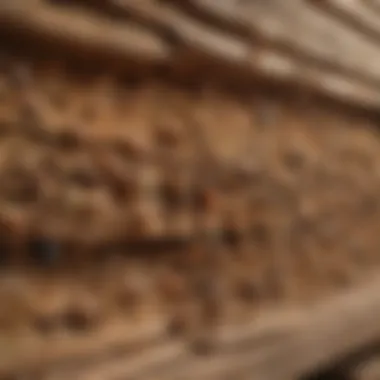

Intro
Termites are often referred to as the hidden threat, gnawing away at the very foundations of homes while remaining out of sight. For homeowners, understanding termite treatment is not merely about eliminating an infestation; it’s about safeguarding one’s investment and ensuring long-term structural integrity. The complexities surrounding termite management demand a nuanced approach, diving into pest identification, prevention strategies, and treatment options.
Through this guide, we aim to equip homeowners and DIY enthusiasts alike with essential knowledge in dealing with these relentless pests. Gaining insights into the behaviors and signs of termites can empower individuals to act swiftly, ultimately protecting their homes from potential damage and expenses that arise from unchecked infestations.
Pest Identification
Understanding what you’re up against is often the first and most crucial step in managing any pest problem. Termites have a certain stealthiness that makes identification a bit tricky.
Detailed Descriptions of Common Pests
Several species of termites are out there, each with its distinct characteristics:
- Subterranean Termites: Known for their wood-eating habits, they live underground and build mud tubes to access food sources. They often swarm in the spring.
- Drywood Termites: These little critters prefer dry wood, and can infest beams, furniture, and any wooden structure. Often you don’t see them until it’s too late.
- Dampwood Termites: As the name suggests, they are attracted to moist and decaying wood. They thrive in environments where moisture is prevalent.
Understanding these common types can help in identifying what you might be dealing with in your home.
Signs and Symptoms of Infestations
Spotting a termite infestation early increases chances of successful treatment. Be on the lookout for:
- Mud Tubes: These pencil-thin tubes are built by subterranean termites to protect themselves as they travel between the underground nest and food sources.
- Swarmers: Flying termites indicate a nearby colony and are usually found near windows or lights.
- Wood Damage: Hollow sounding wood when tapped gently can be a sign of termite activity.
- Frass: This is the term for termite droppings. It appears as small pellets and can often be found near entry points.
“An ounce of prevention is worth a pound of cure.” – Benjamin Franklin
Identifying these signs promptly can mean the difference between minimal repairs and costly renovations.
Prevention Strategies
Prevention is oftentimes more effective than dealing with an established infestation. Here are some practical strategies:
Home Maintenance Tips for Pest Prevention
- Regular Inspections: Check for signs of dampness, wood decomposition, or mud tubes around the foundation.
- Proper Ventilation: Ensure crawlspaces and attics are adequately ventilated to discourage moisture build-up.
- Landscape Awareness: Keep mulch, dirt, and wood piles away from your foundation to limit access.
Natural Deterrents and Barriers
Some homeowners prefer natural methods in lieu of harsh chemicals:
- Boric Acid: This can be used as a bait and is considered less toxic to humans and pets.
- Nematodes: Microscopic worms that target and kill termites naturally in the soil.
- Cayenne Pepper: Mixing this with water to create a spray can help deter termites from entering the home.
These approaches can provide a layer of protection without introducing harmful substances into your environment.
Treatment Options
When prevention fails, treatment becomes necessary. Let’s discuss the different options available:
Overview of Chemical vs. Natural Treatments
- Chemical Treatments: These are often regarded as the mainstay when it comes to termite control. Options include liquid termiticides and baiting systems.
- Natural Treatments: As already mentioned, methods like boric acid or essential oils can be effective without the toxicity associated with chemicals.
Step-by-Step Guides for DIY Treatments
For those inclined to tackle the issue personally, here’s a basic guide:
- Identify the Problem: Ensure it’s definitely termites causing the damage.
- Assess the Damage: Evaluate how extensive the infestation is.
- Implement Treatment: Use the chosen method (chemical or natural) following all instructions carefully. Ensure proper protection.
- Monitor: After treatment, continuously check for any signs of re-infestation.
Being proactive with termite treatment can save homeowners a whole lot of headaches down the road. Armed with knowledge, each homeowner can safeguard their residence effectively, ensuring it's a cozy, safe haven!
Defining Termite Treatment
When it comes to protecting your home, understanding termite treatment is paramount. This topic not only covers the processes involved in eliminating these pests but also emphasizes the significance of acting swiftly when faced with infestations. Early intervention can save homeowners time, damage, and, ultimately, a lot of money.
The Importance of Timely Intervention
Timely intervention in termite treatment cannot be overstated. Imagine finding out that these small critters have been munching away at the wooden framework of your house for months. The signs might be subtle at first, but once they get established, the damage they can cause is nothing short of catastrophic. Homeowners are often caught in a bind, thinking they can put off treatment, only to find that delaying has turned a minor issue into a full-blown crisis.
"A stitch in time saves nine"—the age-old adage applies here, urging you not to wait until it's too late.
The weight of considering potential damage — structural weaknesses, repair costs, and the emotional toll of dealing with the aftermath — makes it critical to act as soon as you suspect a problem. By undertaking timely termite treatment, you are not just protecting your property; you are safeguarding your peace of mind.
Understanding Termite Behavior
Getting a grip on termite behavior lays the groundwork for effective treatment. These insects have a complex social structure and their behaviors are essential in understanding how to manage an infestation effectively.
Life Cycle of Termites
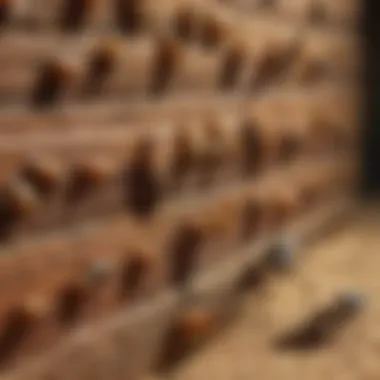

The life cycle of termites is a fascinating aspect of their behavior that plays a crucial role in infestation dynamics. From eggs to nymphs, and finally to mature winged termites, each stage has its part to play. A key characteristic is their rapid reproduction rate that can lead to swarms that seemingly appear overnight. This is a significant topic in the broader narrative of termite treatment because awareness of this cycle gives homeowners insight into how quickly a small problem can spiral out of control.
One unique feature of the termite life cycle is the differentiation between reproductive and worker castes, which can be advantageous as it affects how you might want to approach treatment.
Colonization Patterns
Colonization patterns are another fundamental behavior of termites. They prefer specific environments which can dictate how and where infestations occur. Understanding these patterns allows homeowners to predict where termites are likely to settle. A striking aspect of their colonization is their ability to create a network that spreads quickly through hidden pathways in wood and soil.
The implications of these patterns cannot be understated. Knowing where to look and how to identify those initial signs of colonization can help homeowners be proactive. It’s often the case that a little knowledge goes a long way, equipping you with the tools needed to mitigate potential threats before they escalate into a full-blown infestation.
Types of Termites
In the world of pest control, an understanding of the various types of termites is fundamental for tailored treatment approaches. Termites, often dubbed as nature’s recyclers, can wreak havoc in homes if not managed properly. This article will delve into the characteristics, behaviors, and treatment considerations for different varieties of termites. Each type has unique traits that inform how one should best handle infestations effectively.
Subterranean Termites
Subterranean termites are often the most notorious among all termite species. They thrive underground and prefer damp, moist environments, making the soil their primary habitat. Vigilance is vital since their presence is usually gauged through the damage they inflict on wooden structures, often well hidden beneath the surface.
These pests construct mud tubes, which serve as protective highways for their travels between the ground and wood sources. Homeowners should be on the lookout for these telltale signs. Did you know that subterranean termites are responsible for causing billions of dollars worth of damage yearly? This stark statistic underlines the importance of prompt detection and treatment.
Key Characteristics:
- Habitat: Typically grown in soil, especially in areas with high moisture levels.
- Diet: They feed on cellulose found in wood, paper, and other plant matter.
To combat these termites, treatments often include liquid termiticides and baiting systems. Liquid treatments create a barrier while baiting systems lure termites to a poisoned bait that they take back to their colonies.
Drywood Termites
Drywood termites, unlike their subterranean cousins, do not need contact with the ground to survive. They live in wooden structures and can cause damage without exterior signs of an infestation. As their name implies, these termites prefer dry wood, which makes them commonly found in attics and structural beams.
Watching for signs of drywood termite activity can be tricky since they might be inside your walls or ceiling. One of their indicators includes the presence of small fecal pellets which tend to drop out of infested wood.
Key Characteristics:
- Habitat: Inside wood, often in higher places like attics.
- Diet: Wood, especially dry wood, and furniture.
The treatments for drywood termites can be more invasive, including heat treatments and fumigation. With fumigation, a sealed envelope of the infested area is gassed to eliminate termites. Homeowners should discuss these options with pest control professionals for effective resolution.
Dampwood Termites
Dampwood termites thrive in, as the name suggests, damp or decaying wood. They require high moisture levels, making them common in regions with significant rainfall or areas where wood has not been properly dried. If the wood in your home is consistently moist or decayed, you may need to keep an eye out for these pests.
These termites often don't pose a threat to well-constructed homes but can be problematic in structures where wood is in direct contact with soil or if moisture management has been inadequate.
Key Characteristics:
- Habitat: Rotting or damp wood, often found outdoors.
- Diet: Prefer wood that is decaying and has a high moisture content.
Treating for dampwood termites usually involves reducing moisture levels and ensuring proper ventilation, alongside targeted treatments that can prevent infestations from taking root.
Understanding the type of termite is the first step in selecting the right treatment method. Each termite has an affinity for different conditions and materials, making tailored interventions crucial for effective pest management.
In summary, termites exist in various types, each exhibiting distinct behaviors and preferences that affect treatment strategies. Knowing which termite is creating a problem not only allows for timely intervention but also strengthens the foundation of prevention going forward. By understanding these differences, homeowners can take a proactive stance in safeguarding their properties against these destructive pests.
Identifying Termite Infestations
Identifying termite infestations is not just a trivial task. It's often the first line of defense in protecting your home from significant damage. Being able to spot the early signs can save you a heap of trouble and money in the long run. Termites, as many homeowners know, are notorious for their destructive capabilities, and a swift recognition of their presence is crucial. When you identify an infestation early, you can act quickly, often preventing extensive structural damage. This section will explore the various indicators that can help you distinguish between a termite-laden home and a safe haven.
Signs of Infestation
Wood Damage
Wood damage stands as one of the most tell-tale signs of termites. Termites feast on cellulose material found in wood, and damage might be found where you least expect it. A distinct characteristic of wood damage is the hollow sound it produces when tapped lightly. If you're hearing that strange echo, it might be worthwhile to investigate.
One of the unique features of wood damage is its often stealthy nature; the external wood may appear untouched, yet once you look deeper, the interior structures reveal devastation. Ignoring these signs can lead to more extensive repairs down the line, making wood damage something you can't afford to shrug off.
"Early detection of wood damage is akin to catching a thief before they even enter your home—prevention is key!"
Whether or not to address wood damage often hinges on its extent. Minor damage might only need a plastic wood filler, but extensive damage will require heavier structural repairs.
Swarms and Droppings
Swarms and droppings are another major indicator when it comes to identifying termite infestations. Termites aren't shy about making their presence known, especially during warmer months when mating season hits. A key aspect of swarming is that these insects leave behind discarded wings, which can accumulate near windows or light sources. This is one way to gauge whether termites have made a home nearby.
On the other hand, termite droppings, often referred to as frass, can serve as another red flag. These tiny, wood-colored pellets are a direct sign that the bugs have been active in the area for a while. The distinct characteristic of droppings is their rough, granular texture, which can help you differentiate them from other insect waste.
Both swarms and droppings serve as strong warning signals. By being vigilant and observant, you can take necessary actions before things spiral out of control.
Inspection Techniques
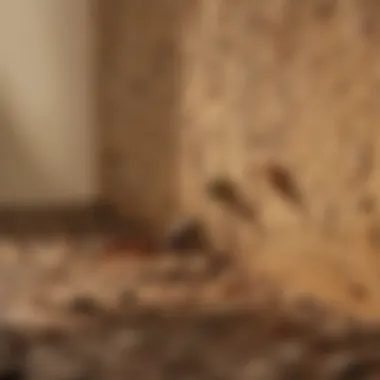

Identifying infestations goes hand-in-hand with comprehensive inspection techniques. Knowing how to inspect your home facilitates early detection and can guide effective action.
Visual Inspections
Visual inspections are the bread and butter of spotting termite issues. During this assessment, you should be on the lookout for any signs of damage, such as blisters in wood flooring or mud tubes leading up the walls. The hallmark of visual inspections lies in their straightforwardness. You don’t need specialized tools to get started. Often, a simple flashlight and a keen eye can reveal a lot.
This approach allows you to get up close and personal with potential problem areas in your home, revealing signs that might be missed during a cursory glance. On the flip side, the subjective nature can lead to occasional oversights, especially for those unfamiliar with specific warning signs.
Tools for Detection
Utilizing tools for detection raises your game in finding infestations. Technology such as infrared cameras can help identify moisture, which might indicate a termite problem. Furthermore, equipment like acoustic sensors can listen for the sounds made by termites as they munch away at your wooden structures. The advantage of these tools is their ability to detect infestations that are otherwise hidden from the naked eye.
However, this method does require an investment, both in terms of money and time to learn how to use the tools effectively. Balancing a visual inspection with tools could optimize identification efforts.
By combining early detection through signs of infestation, solid inspection techniques, and remaining vigilant, homeowners can turn the tide against termites, keeping their sanctuaries secure.
Preventive Measures Against Termites
When it comes to protecting your home from termite invasions, prevention is the name of the game. With termites being notoriously destructive and difficult to detect until significant damage has already been done, homeowners need to be proactive in their approach. Implementing preventive measures can not only save you from costly repairs but also give you peace of mind. A little foresight goes a long way in this regard.
Landscape Management
Landscaping can significantly impact your home’s vulnerability to termites. With a few strategic adjustments, you can deter these pests right from the get-go.
Proper Drainage
Having a robust drainage system is not just good for your garden; it’s essential for preventing termite infestations. Water buildup around your foundation can create an inviting environment for subterranean termites, who thrive in moist conditions. Essentially, ensuring proper drainage keeps moisture away from your home’s base, reducing the attraction for these pests.
One key characteristic of a well-designed drainage system is the effective routing of rainwater away from your house. French drains, for example, can be particularly beneficial. However, if they are not installed correctly or maintained regularly, they can indeed become a trap for unwanted moisture, making it a less favorable environment.
What sets proper drainage apart is its dual function: it doesn’t just prevent termite infestations—it also helps maintain the overall health of your landscape. Keep in mind, maintaining proper drainage by regularly clearing gutters is a worthwhile investment for any homeowner.
Wood Mulch Considerations
While wood mulch can enhance your garden's aesthetic and serve as a good insulator for the soil, it can also be a feast for termites if not managed diligently. One aspect to consider is the placement of the mulch. Keeping it a few inches away from your home’s foundation can minimize potential threats.
The key characteristic of wood mulch is its organic nature, which termites find enticing. This aspect is why homeowners often enjoy its benefits, but it does carry risks. A unique feature of wood mulch is its ability to retain moisture, which, while beneficial for plants, can be a beacon for termites.
Therefore, choosing alternative mulch materials, like gravel or rubber mulch, can be a safer option in termite-prone areas. Keeping wood mulch dry and monitoring moisture levels can go a long way in this preventive strategy.
Structural Repairs
While landscape management is essential, addressing structural issues is equally critical in reducing the risk of termite problems. Small repairs can make a big difference when it comes to sealing your home from these pesky pests.
Sealing Cracks and Gaps
Cracks and gaps around windows, doors, and the foundation invite not just drafts but also termite invasions. These pests are agile and can find seemingly insignificant openings to gain entry.
A key characteristic of sealing cracks is its straightforwardness; you don’t need a degree in construction to apply caulk or fill cracks with sealants. This simple yet effective choice signifies proactive homeowner behavior—it shows you care enough to maintain your home’s integrity.
However, while sealing is beneficial, it’s crucial to use appropriate materials. For example, merely patching with any old filler may not hold over time or resist moisture. Thus, ensuring the right products are utilized can yield long-term benefits against infestations.
Termite Barriers
Installing physical termite barriers around your home serves as an effective line of defense against invasions. These barriers, which can be made of various materials, serve to restrict the access points termites typically exploit.
The standout feature of termite barriers is their durability; many can last for decades if installed correctly. Their popularity stems from their low maintenance once in place. However, there is a downside: they often require a professional installation, which can be a hefty initial investment for some homeowners. Nonetheless, the long-term protection they offer certainly justifies the expense for many.
Treatment Options for Termites
When dealing with termite infestations, knowing your treatment options is crucial. This section dives into the methods available to combat these pests, weighing their effectiveness, practicality, and potential drawbacks. Selecting the right option can mean the difference between a short-term fix and a long-lasting solution that protects your home and investment.
Chemical Treatments
Chemical treatments are among the most widely used solutions for termite control. These methods offer homeowners targeted and often rapid results against infestations. Understanding the intricacies of these treatments is vital for making informed decisions.
Liquid Termiticides
Liquid termiticides have been a staple in pest management due to their direct application method. They act as a barrier that prevents termites from infiltrating structures. What sets liquid termiticides apart is their dual-action nature; they not only repel termites but can also kill them on contact. This makes them a prominent choice for homeowners looking to ensure immediate defense against infestations.
One unique feature of liquid termiticides is their long-lasting residual effect. Once applied, they can provide protection for years, significantly reducing the risk of future infestations. However, there are considerations to keep in mind: these chemicals often require professional application and may have environmental impacts that should not go unnoticed.
Baiting Systems
Baiting systems represent a more strategic approach to termite management. Unlike liquid termiticides, which create barriers, baiting systems lure termites to a bait station where they ingest a slow-acting insecticide. This method targets the entire colony, making it quite effective in the long run.
A key characteristic of baiting systems is their low environmental impact. Since the application is localized, there’s less risk of chemical runoff into the ecosystem. Nonetheless, it’s essential to note that baiting systems require ongoing monitoring and maintenance. This method may take longer to reduce termite populations compared to instant chemical treatments, yet it can provide a more sustainable solution over time.
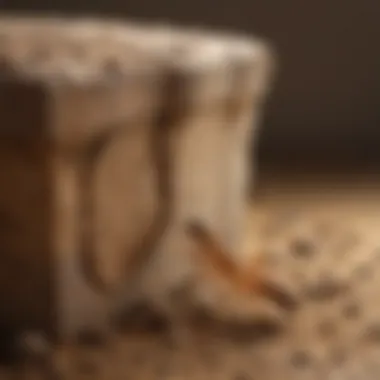

Natural Remedies
Natural remedies are gaining traction among homeowners who seek eco-friendly pest control solutions. They present an alternative to traditional methods while still offering effective means to combat termites.
Essential Oils
Essential oils, particularly those derived from plants like clove, cinnamon, and neem, have gained attention for their insect-repelling properties. The appeal of essential oils lies in their natural origins and the fact that they pose less risk to humans and pets when used properly. They can be applied directly to affected areas, potentially disrupting termite behavior and inhibiting their ability to thrive.
One distinct advantage of essential oils is their pleasant scent compared to harsh chemical alternatives. However, effectiveness can vary, and repeated applications are often needed, making them less ideal for large-scale infestations. Householders who adopt this method need to remain consistent and vigilant in their application practices.
Beneficial Nematodes
Beneficial nematodes are microscopic roundworms that serve as natural predators to termites. These organisms enter the termites' bodies, releasing bacteria that ultimately kill them. Their use reflects a shift towards biological control methods, providing a method safe for the environment and non-target species.
A key factor that makes beneficial nematodes appealing is their self-perpetuating nature; they can breed within the soil, prolonging their pest control benefits. However, they require careful handling and conditions for effective results. They thrive in moist environments but can quickly perish under dry or extreme conditions. Proper timing and monitoring are paramount.
Heat and Fumigation Methods
For extensive infestations, heat treatment and fumigation present powerful options, often necessitating professional intervention. These methods are robust and rely on the principles of extermination through heat or chemical infiltration.
Heat Treatment Process
The heat treatment process involves raising the temperature of infested areas to levels that are lethal to termites, usually around 120°F (49°C) for an extended period. The ecological advantage here cannot be overstated; no chemicals are involved, making it a safer choice for families.
However, one must consider the specificity of this method—it's crucial that the treatment penetrates all parts of the structure, which may not always happen effectively. Also, costs can be higher than standard chemical treatments, as specialized equipment and trained professionals are often necessary.
Fumigation Overview
Fumigation is typically employed for serious infestations within an entire structure. It entails sealing the building and dispersing gas that infiltrates every nook and cranny, ensuring no termite is left behind. This comprehensive approach guarantees thorough exposure to the active ingredient, an attractive feature for those facing severe problems.
Despite this effectiveness, several downsides exist. Homes undergoing fumigation require occupants and pets to vacate for a few days, creating significant inconvenience. Additionally, the use of gaseous pesticides may raise concerns about environmental safety and long-term health effects. It’s not a light decision, but the results can be game-changing.
In summary, a combination of treatment options tailored to the specific situation often yields the best results.
After-treatment Considerations
Once termite treatment is completed, it’s crucial to focus on after-treatment considerations. This part of the process is often overlooked, but it can greatly influence the long-term success of your pest control efforts. The core objective after treatment is to ensure that the termites stay gone for good. Failing to take necessary steps can lead to a resurgence of these invasive pests, often at a much higher cost in the future.
Monitoring Infestations
Regular Inspections
Regular inspections play a significant role in effective termite control. The most essential aspect of these inspections is their frequency. Conducting inspections at least once a year is generally advisable, but depending on your area and past infestations, you might want to increase this frequency. The key characteristic of regular inspections is their proactive nature, allowing for the early detection of any signs of a returning issue.
Regularly inspecting your property helps in identifying potential vulnerabilities like moisture-rich areas where termites are drawn to. What sets this apart from less frequent evaluations is the immediacy of feedback you receive. With a keen eye trained on the common signs of infestation, homeowners can detect problems before they escalate. However, it’s vital to remember that while inspections are beneficial, they require diligence and a bit of effort.
Establishing a Maintenance Plan
Creating a maintenance plan is another essential post-treatment task. This involves outlining a clear strategy for managing your property’s defenses against termites in the long-run. Having a solid maintenance plan creates a safety net against potential infestations. It’s a beneficial choice for any homeowner looking to protect their investment.
One unique feature of a maintenance plan is that it can be customized based on your specific situation. A well-documented plan might include scheduled inspections, treatment reminders, and updates based on local pest activity reports. While this requires initial effort to establish, the advantages far outweigh the time invested. On the downside, the commitment to follow through with the plan can sometimes lead to it being cast aside, making consistent engagement crucial to its effectiveness.
Long-term Solutions
Community Awareness Programs
Community awareness programs can serve as a robust way to tackle termite problems comprehensively. One specific aspect of these initiatives is the emphasis on education; the more individuals know about termites and their warning signs, the better prepared the community will be to act defensively. This makes community awareness programs a popular choice for neighborhoods prone to termite disturbances.
What stands out about these programs is the collaborative aspect. Neighbors can come together, sharing resources and knowledge that not only empower individuals but also unify collective action against infestations. However, despite their benefits, these programs can face challenges such as lack of engagement or coordination among participants, leading to varying levels of effectiveness.
Collaborative Pest Management
Collaborative pest management involves integrating efforts from multiple parties, including pest control professionals, researchers, and community members. This aspect aims to create a synergistic relationship among all stakeholders to develop stronger, more accurate methods for addressing termite issues. It’s a beneficial approach because it pools knowledge and resources, leading to better outcomes than any solitary effort.
The unique feature of collaborative pest management is its emphasis on ongoing dialogue and partnership. It encourages the sharing of successful strategies and fosters an environment of trust and cooperation. However, while this collective effort can lead to significant advancements, it can also pose challenges such as potential disagreements among participants or differences in priorities that may hamper progress.
"Investing time in after-treatment measures can save you a headache in the long-run. Don't let your efforts go to waste!"
End
Understanding termite treatment is more than just a chore; it’s a necessity for homeowners who wish to protect their investment and maintain the sanctity of their living spaces. This section distills the essence of the entire guide, focusing on the myriad ways in which timely knowledge and action come together in the fight against these wood-destroying pests. By now, it’s clear that ignoring the presence of termites can result in catastrophic consequences, not just in terms of structural damage but also in the financial implications tied to repairs and treatment.
Key Takeaways
- Identify Early: A major premise discussed throughout is the importance of early detection. Spotting the signs of an infestation—like mud tubes or discarded wings—can save homeowners from extensive damage and costly repairs.
- Diverse Treatment Options: Whether one leans towards chemical treatments or natural remedies, there are multiple pathways to tackling infestations. Understanding the options available helps in making informed, effective choices that align with individual needs and circumstances.
- Long-term Commitment: Prevention doesn't stop after treatment. The article highlights how regular inspections and community awareness can significantly diminish the likelihood of reinfestation. A proactive approach is essential for sustainable pest management.
Through the lens of prevention, identification, and treatment strategies, readers gain a comprehensive understanding that transcends just surface knowledge. Thus, it lays groundwork to not only deal with current infestation issues but to effectively anticipate and prevent future ones as well.
Advocating for Sustainable Practices
The journey in understanding termite treatment also leads to a broader conversation about sustainability. As we become more aware of our environmental footprint, advocating for eco-friendly pest control methods becomes increasingly significant. Homeowners should consider how their choices impact not just their property but the ecosystem at large.
- Choose Natural Remedies: Emphasizing alternatives to harsh chemicals can protect not only the home but the surrounding environment. For instance, essential oils like clove or orange oil can be powerful deterrents without introducing harmful toxins into the home.
- Community Initiatives: Engaging in community awareness programs fosters a shared responsibility toward pest management. Collaborating with neighbors on termite prevention measures ensures a more substantial defense against these pests.
- Regular Education: Stay informed about sustainable practices and emerging technologies. New developments in pest control continuously evolve. Arm yourself with information by accessing resources like Wikipedia or Britannica. Joining discussion forums such as Reddit can also provide community insights.
"Sustainable practices are not only about reducing harm today but ensuring that future generations can enjoy their homes free from the threats of pests."


